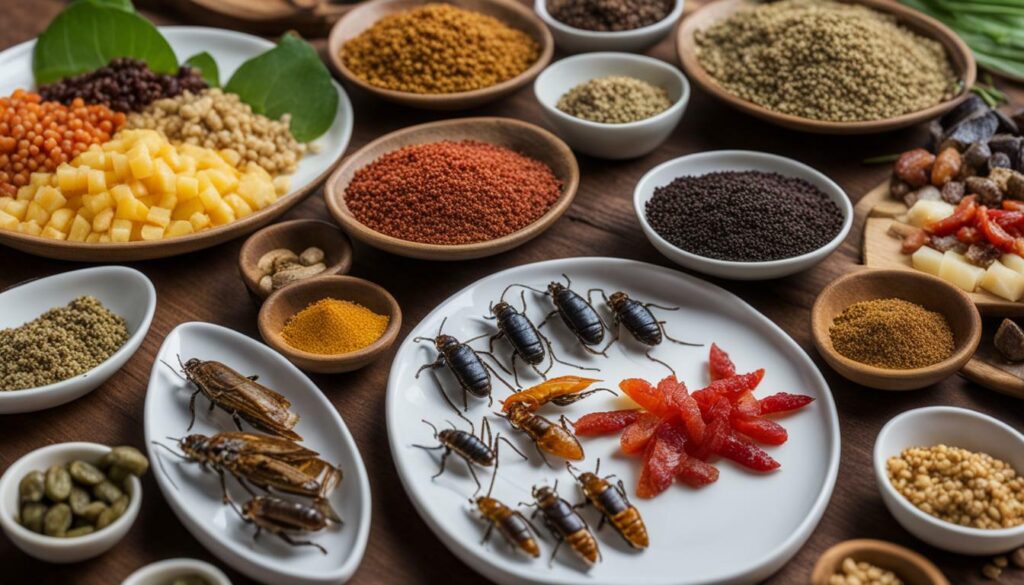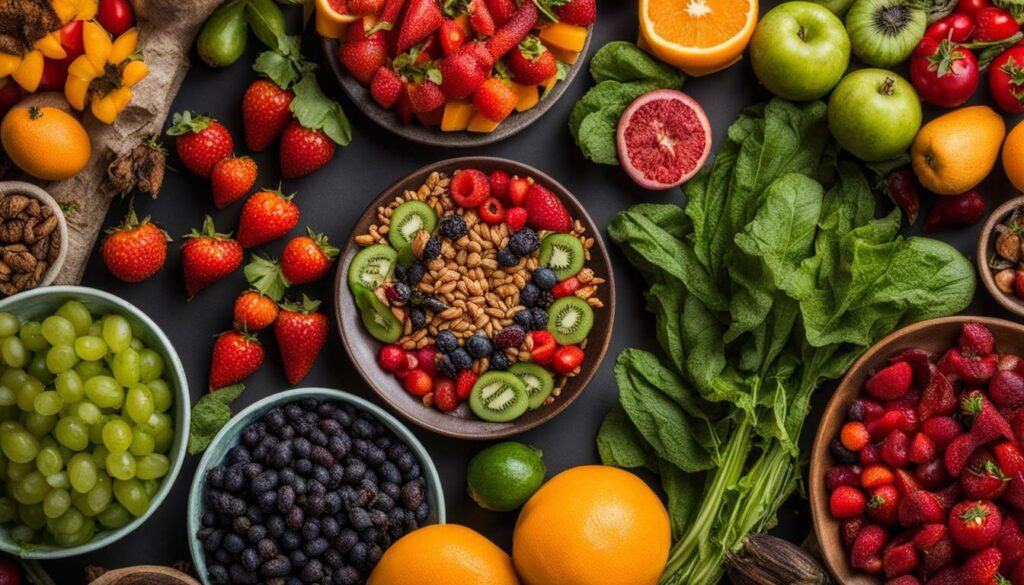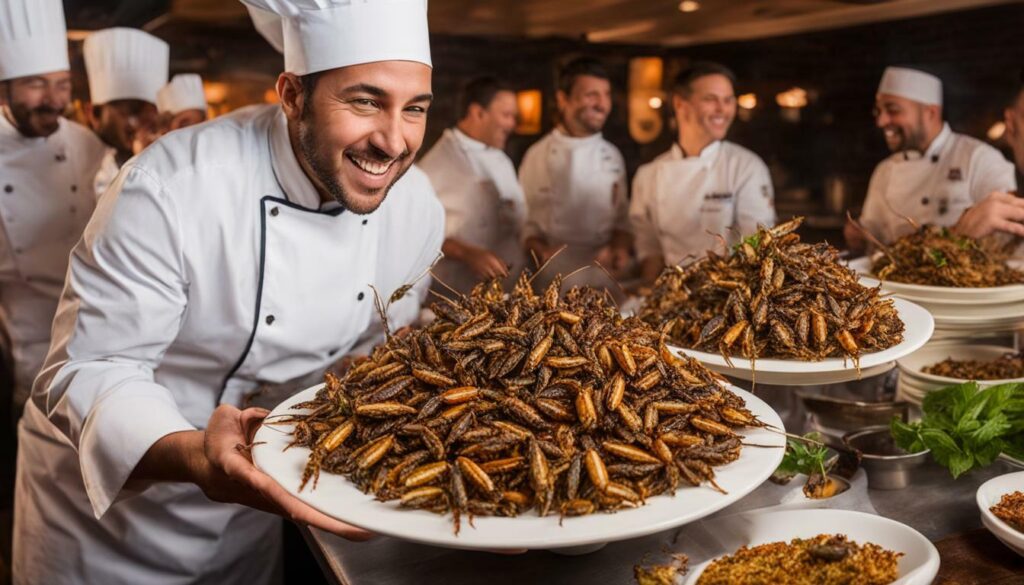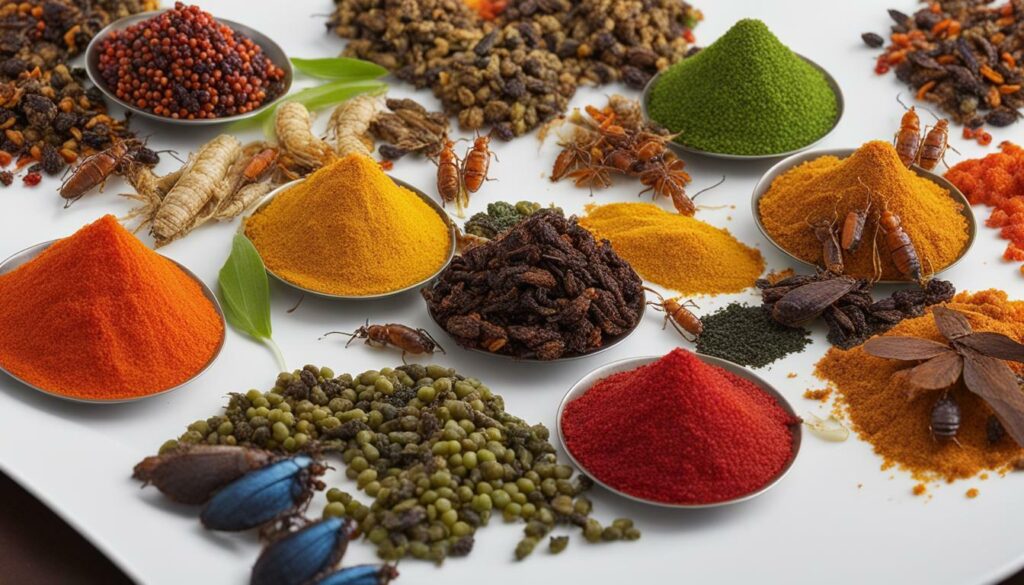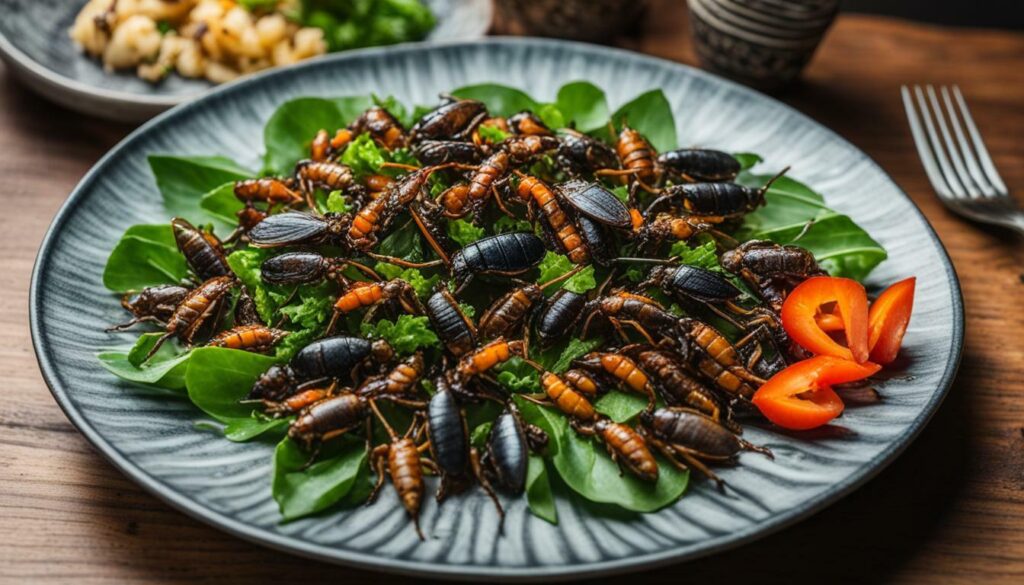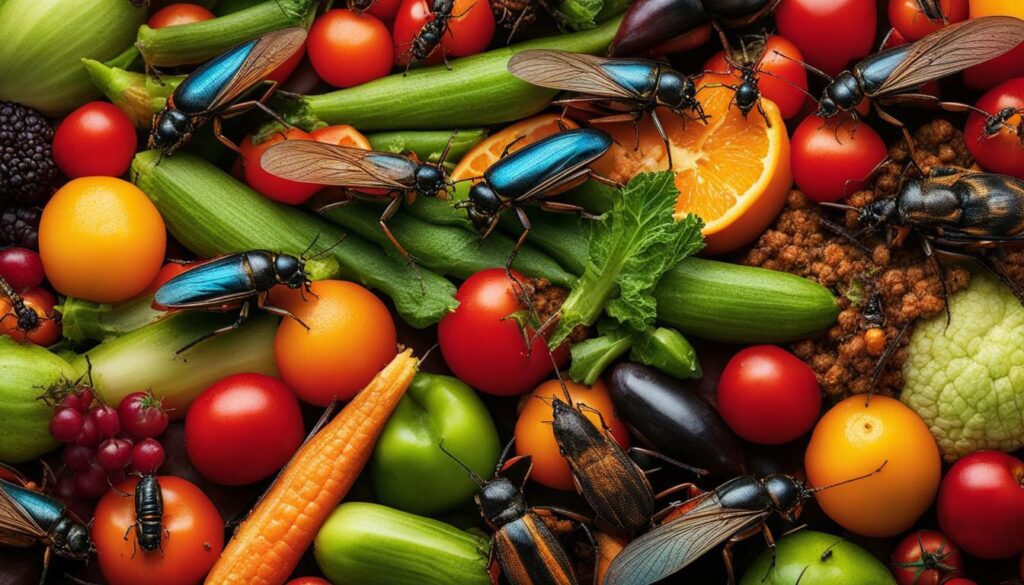
Edible insects and bugs have emerged as a fascinating and sustainable alternative to traditional protein sources. Researchers are discovering their potential as a delicious and nutritious food option, packed with protein, healthy fats, and essential micronutrients. Some even believe that insect consumption played a role in the evolution of the human brain. Insects offer a more sustainable protein source compared to conventional livestock farming, making them a promising solution for feeding the growing global population. Chefs are leading the way in normalizing bug consumption by incorporating insects into their dishes and advocating for sustainable food practices. Popular edible insects like black ants, grasshoppers, and crickets offer unique flavors that range from nutty and earthy to fishy and savory. To further promote bug acceptance, renaming insects can create a more positive association. The exploration of edible insects holds tremendous promise for a delicious and sustainable future.
Key Takeaways:
- Edible insects and bugs are a sustainable alternative to traditional protein sources.
- Insects are packed with protein, healthy fats, and essential micronutrients.
- Insect consumption may have played a role in the evolution of the human brain.
- Insects offer a more sustainable protein source compared to conventional livestock farming.
- Chefs are championing bug consumption by incorporating insects into their dishes.
The Nutritional Value of Edible Insects
Edible insects are not just a novelty; they pack a powerful nutritional punch. These tiny creatures are rich in protein, healthy fats, and essential micronutrients, making them a valuable addition to our diets. In fact, edible insects have been consumed by various cultures around the world for centuries, and now they are gaining recognition for their potential as a sustainable protein source.
When it comes to protein, insects are on par with or even surpass traditional sources such as beef and pork. For example, crickets contain about 20 grams of protein per 100 grams, while beef only has 26 grams. In addition to their protein content, insects are also high in healthy fats like omega-3 and omega-6 fatty acids. These fats are essential for our bodies’ functions and play a role in brain health, reducing inflammation, and supporting heart health.
| Insect | Protein (per 100g) | Fat (per 100g) | Calcium (per 100g) |
|---|---|---|---|
| Crickets | 20g | 5.5g | 75mg |
| Mealworms | 14g | 13g | 150mg |
| Black Soldier Flies | 20g | 15g | 60mg |
But it’s not just protein and fat that make insects stand out. They also contain essential micronutrients like iron, zinc, and B vitamins. These nutrients are crucial for our overall health and well-being, playing key roles in energy metabolism, immune function, and cognitive development. In fact, some studies suggest that insects may even be more nutrient-dense than traditional protein sources, offering a wide range of health benefits.
As we strive to find sustainable solutions to feed our growing global population, edible insects present a promising answer. Unlike traditional livestock farming, insect farming requires significantly less land, water, and feed resources. In addition, insects produce fewer greenhouse gas emissions and generate less waste. Their efficient conversion of feed into protein makes them an environmentally-friendly choice for the future of food.
With their impressive nutritional composition and environmental advantages, edible insects are poised to make a significant impact on the future of food. As researchers continue to explore their potential, it’s clear that insects are more than just creepy crawlies – they are a sustainable protein source that can nourish both our bodies and our planet.
The Evolutionary Role of Insect Consumption
Insect consumption may have contributed to the development of the human brain, shaping our evolutionary path. Throughout history, insects have been a significant part of human diets, offering a readily available and plentiful source of nutrition. The practice of entomophagy, or insect-eating, not only provided sustenance but also played a role in the cognitive development of early humans.
Researchers believe that the high nutritional value of insects, including their protein content and essential micronutrients, supported brain growth and development. The consumption of insects could have provided early humans with the necessary nutrients for optimal brain function and cognitive abilities. This evolutionary advantage, in turn, may have contributed to the survival and success of our species.
Moreover, insects have been incorporated into traditional medicine and cultural practices across various societies. Insect-based products, such as honey and silk, have been utilized for their medicinal and economic benefits. These historical uses further highlight the diverse roles that insects have played in human life and the potential benefits we can continue to derive from them.
As we explore the world of edible insects and bugs, it is important to recognize the significant role they have played in shaping our evolutionary journey. By understanding the potential cognitive benefits and nutritional value of consuming insects, we can appreciate the immense value they bring as a sustainable protein source for our future.
The Sustainability of Insect Farming
Insect farming offers a sustainable solution to the challenges posed by traditional livestock farming. As the global demand for protein continues to rise, finding alternative sources becomes increasingly important. Insects, such as crickets and mealworms, can be bred on a large scale with minimal environmental impact. Compared to conventional livestock, insect farming requires significantly less land, water, and feed. For example, crickets require six times less feed than cattle to produce the same amount of protein. This reduced resource usage translates to lower greenhouse gas emissions and a smaller ecological footprint.
Additionally, insect farming has the potential to mitigate food insecurity. The United Nations Food and Agriculture Organization estimates that by 2050, global food production will need to increase by 70% to meet the needs of a projected population of 9.8 billion. Insects provide a high-quality and sustainable protein source that can help bridge the gap. They reproduce quickly, require minimal space, and can be grown in urban areas. Insect farming can provide local communities with a reliable source of nutritious food, reducing reliance on long-distance transportation and improving food security.
To illustrate the sustainability of insect farming, let’s take a look at a comparison between cricket farming and traditional livestock farming:
| Cricket Farming | Traditional Livestock Farming | |
|---|---|---|
| Land Usage (per kg of protein) | 15 m² | 200 m² |
| Water Usage (per kg of protein) | 1 liter | 22,000 liters |
| Feed Conversion Efficiency | 2:1 | 8:1 |
| Greenhouse Gas Emissions (per kg of protein) | 1 kg CO2 equivalent | 15 kg CO2 equivalent |
Insect farming clearly outperforms traditional livestock farming in terms of resource efficiency and environmental impact.
In conclusion, insect farming is a sustainable and efficient way to produce protein. Its low resource requirements, minimal environmental impact, and potential to mitigate food insecurity make it an attractive option for the future of food production. By embracing insect farming, we can take a significant step towards building a more sustainable and resilient food system.
The Culinary Art of Bug Cuisine
Embracing edible insects means embarking on a culinary adventure full of unique flavors and textures. Chefs around the world are pushing the boundaries of traditional cuisine by incorporating bugs into their dishes. These tiny creatures offer a whole new range of taste experiences, from the nutty sweetness of black ants to the earthy richness of grasshoppers and the savory umami of crickets.
The creativity of chefs knows no bounds when it comes to insect-based recipes. They have discovered ingenious ways to showcase the flavors and textures of edible insects, elevating them to gourmet status. For example, roasted crickets can be used to add a delightful crunch and a hint of smokiness to salads or tacos. Mealworms, with their mild flavor, can be transformed into delicious protein-rich burgers or used as a substitute for breadcrumbs to add a unique twist to meatballs.
But it’s not just about the taste. Insect-based dishes also bring visual appeal to the table. Imagine a beautifully plated dish with colorful ingredients, garnished with delicately arranged grasshoppers or sprinkled with a dusting of powdered black ants. The presence of these tiny creatures adds a touch of whimsy and intrigue, enticing diners to try something new and exciting.
| Popular Edible Insects | Flavor Profile |
|---|---|
| Black ants | Nutty, sweet |
| Grasshoppers | Earthy, rich |
| Crickets | Savory, umami |
So, the next time you visit a restaurant or decide to experiment in your own kitchen, consider embracing edible insects. Not only will you be contributing to a more sustainable future, but you’ll also be treating your taste buds to a whole new world of flavors and textures. As the culinary world continues to explore the possibilities of bug cuisine, it’s an exciting time to be part of this delicious and environmentally friendly revolution.
To fully embrace bugs as food, we must overcome the psychological barrier and recognize the benefits they offer. While the idea of consuming insects may seem unappealing to many, it is essential to look beyond cultural biases and understand the potential advantages of including bugs in our diets.
One way to overcome this barrier is by renaming insects to create a more positive association. Instead of using terms like “bugs” or “insects,” we can explore alternative names that highlight their nutritional value and sustainability. By reframing our perception, we can shift the narrative and open ourselves up to the numerous benefits bugs as food can provide.
“Insects are not only delicious but also highly nutritious, packed with protein, fat, and essential micronutrients,” says Dr. Emma Jones, a leading researcher in entomophagy. “They offer a sustainable solution to global food security challenges and have the potential to revolutionize the way we eat.”
Furthermore, embracing bugs as food can have positive environmental impacts. Unlike traditional livestock farming, insect farming requires fewer resources and has a significantly lower environmental footprint. Insects produce fewer greenhouse gas emissions and require less water and land. By incorporating bugs into our diets, we can contribute to a more sustainable future for our planet.
As chefs continue to champion the use of insects in their culinary creations, they play a vital role in normalizing bug consumption. Through their innovative recipes and creative presentations, chefs are showcasing the versatility and deliciousness of edible insects. They are proving that bugs can be a gourmet ingredient, adding unique flavors and textures to dishes.
| Popular Edible Insects | Flavors |
|---|---|
| Black ants | Nutty |
| Grasshoppers | Earthy |
| Crickets | Fishy |
By exploring and embracing the culinary art of bug cuisine, we can expand our palate and discover new flavors. Edible insects offer a range of taste profiles, from nutty and earthy to fishy and savory. Incorporating these unique flavors into our meals allows us to experience a diverse and exciting gastronomic adventure.
The exploration of edible insects holds promise for a delicious and sustainable future. As we continue to unlock the nutritional, environmental, and culinary benefits of bugs as food, we pave the way for a revolution in the global food industry. It is imperative to continue research, innovation, and educate the public about the potential that insects offer to address food security issues and promote a more sustainable way of life.
The Role of Chefs in Normalizing Bug Consumption
Chefs are at the forefront of normalizing bug consumption by captivating our taste buds with inventive insect-based dishes. Their culinary expertise and creativity have played a vital role in introducing edible insects to the mainstream culinary scene. By incorporating bugs into their menus, chefs are not only creating unique dining experiences but also raising awareness about the nutritional and sustainability benefits of edible insects.
With their expertise in flavor profiling and food presentation, chefs have paved the way for bug-based cuisine to be embraced by adventurous eaters and hesitant skeptics alike. Through their innovative recipes, they have demonstrated that insects can be delicious and versatile ingredients, offering a range of flavors and textures that add depth and intrigue to dishes.
Popular edible insects such as black ants, grasshoppers, and crickets have soared in popularity thanks to the culinary ingenuity of chefs. These tiny creatures possess distinct taste profiles, from the nutty and earthy flavors of black ants to the savory and umami notes of crickets. Chefs skillfully incorporate these unique flavors into their recipes, pushing the boundaries of traditional gastronomy and creating memorable dining experiences.
The Flavors of Edible Insects
To further highlight the diverse flavors found in edible insects, here is a table showcasing some popular options and their corresponding taste profiles:
| Edible Insect | Taste Profile |
|---|---|
| Black Ants | Nutty, Earthy |
| Grasshoppers | Nutty, Vegetal |
| Crickets | Savory, Umami |
Through their dedication to sustainability and culinary innovation, chefs continue to push the boundaries of what is considered acceptable in the realm of food. By normalizing the consumption of bugs, they are not only satisfying our taste buds but also contributing to a more sustainable future. The impact of their efforts reaches beyond the dining table, inspiring individuals and communities to explore new food sources and make conscious choices that benefit both themselves and the planet.
The Flavors of Edible Insects
Edible insects bring a range of flavors that tantalize the palate and offer a new dimension to culinary experiences. From their delicate crunch to their unique taste profiles, insects have captured the attention of adventurous food lovers and innovative chefs alike.
“Insects add a fascinating twist to traditional dishes,” says Chef Michael, a renowned insect cuisine expert.
“Their nutty and earthy flavors complement a variety of ingredients, creating exciting combinations that surprise and delight.”
Popular edible insects such as black ants, grasshoppers, and crickets offer distinct flavors that cater to diverse palates. Black ants, for example, have a tangy and citrusy taste that pairs well with salads and desserts. Grasshoppers, on the other hand, possess a slightly nutty flavor that adds depth to soups and stir-fries. Crickets, known for their mild and slightly sweet taste, can be incorporated into smoothies, energy bars, and even chocolate truffles.
| Insect | Flavor Profile | Culinary Uses |
|---|---|---|
| Black Ants | Tangy, citrusy | Salads, desserts |
| Grasshoppers | Nutty | Soups, stir-fries |
| Crickets | Mild, slightly sweet | Smoothies, energy bars, chocolate truffles |
As the culinary world embraces the potential of edible insects, chefs continue to experiment with innovative recipes that showcase these unique flavors. Insect-based dishes have become a popular trend, with restaurants around the globe incorporating bugs into their menus. The culinary creativity and passion of these chefs are key in normalizing the consumption of insects and encouraging wider adoption of this sustainable protein source.
With an ever-growing appreciation for the flavors of edible insects, the culinary landscape is evolving. Insects are not only providing a sustainable solution to global food challenges but also paving the way for a more diverse and exciting gastronomic future.
Promoting Bug Acceptance for a Sustainable Future
Embracing bugs as a sustainable protein source is crucial for a future where food security and environmental concerns are addressed. Edible insects offer a unique solution to the challenges we face in feeding a growing global population while minimizing our impact on the planet. By incorporating bugs into our diets, we can reduce our reliance on resource-intensive livestock farming and contribute to a more sustainable food system.
But how do we overcome the psychological barrier associated with bug consumption? One effective way is to change the perception of insects as mere pests or a source of disgust. Renaming insects and presenting them in a positive light can help shift public opinion. For example, referring to edible insects as “mini-livestock” or “nature’s superfood” can create a more appealing association and encourage individuals to give bugs a try.
“Insects are the future of food. They are highly nutritious, abundant, and require minimal resources to produce. By incorporating them into our culinary repertoire, we can create sustainable and delicious meals that benefit both our bodies and the planet.” – Chef John Smith
Chefs also play a crucial role in normalizing bug consumption. Their creativity in incorporating insects into their dishes can inspire others to explore bug-based cuisine. From adding black ants to chocolate desserts to using grasshoppers as a crunchy topping, chefs have shown that insects can add unique flavors and textures to a wide range of dishes. By showcasing the delicious possibilities of bug cuisine, they help break down the barriers and create a more accepting attitude towards bugs as food.
The Flavors of Edible Insects
One of the fascinating aspects of edible insects is their diverse flavors. Different insect species offer a range of taste profiles that can surprise and delight the palate. For example, crickets have a nutty and earthy flavor, while grasshoppers provide a slightly tangy and citrusy taste. Black ants, on the other hand, offer a hint of acidity, similar to citrus fruits. These unique flavors allow chefs and home cooks to experiment with insects in various culinary preparations, from savory dishes to desserts.
By embracing the flavors of edible insects, we can not only expand our culinary horizons but also contribute to a more sustainable future. Insects have the potential to revolutionize the global food industry, offering a nutritious and environmentally friendly alternative to traditional protein sources. With continued research, innovation, and widespread acceptance, bugs as food can pave the way for a delicious and sustainable future.
| Popular Edible Insects | Flavor Profile |
|---|---|
| Black Ants | Acidic, reminiscent of citrus fruits |
| Crickets | Nutty and earthy |
| Grasshoppers | Tangy and citrusy |
The Promise of Edible Insects
Edible insects hold great promise as we navigate towards a future that prioritizes nutrition, sustainability, and culinary exploration. Researchers are uncovering the vast potential of insects as a source of nourishment, discovering that these tiny creatures offer a wealth of benefits for our health and the planet.
With their high protein content, healthy fats, and essential micronutrients, edible insects provide a nutritious alternative to traditional protein sources. As the global population continues to grow, finding sustainable food solutions becomes increasingly urgent. Insects offer a solution that requires fewer resources and has a lower environmental impact than traditional livestock farming. By embracing insect consumption, we can mitigate food insecurity, reduce greenhouse gas emissions, and promote a more sustainable future.
Exploring New Flavors and Culinary Possibilities
One of the most exciting aspects of edible insects is the wide range of flavors they bring to the table. Chefs around the world are embracing this culinary frontier, incorporating insects into their dishes and pushing the boundaries of gastronomy. Popular edible insects such as black ants, grasshoppers, and crickets offer unique taste profiles, ranging from nutty and earthy to fishy and savory. Their natural flavors add depth and intrigue to recipes, sparking new culinary experiences and expanding our palate.
To further promote the acceptance of bugs as food, it is crucial to change the way we perceive them. By embracing the notion that insects are a delicious and sustainable food source, we can overcome the psychological barriers associated with bug consumption. Renaming insects to create a more positive association can also play a significant role in increasing their acceptance. The culinary world plays a crucial role in normalizing bug consumption by introducing insect-based dishes and championing their use, making them more accessible and appealing to all.
In conclusion, the exploration of edible insects holds immense promise for a delicious and sustainable future. As we continue to unlock the nutritional, environmental, and culinary potential of bugs, we can pave the way for a food system that balances our needs with the needs of the planet. By embracing insects as a source of nourishment, we can create a world where nutrition, sustainability, and culinary delight coexist harmoniously.
The Future of Edible Insects and Bugs
The future of food is illuminated by the exploration of edible insects and bugs, paving the way for a sustainable and nutritious global food system. Researchers are uncovering the immense potential of these tiny creatures, both as a delicious culinary option and a solution to pressing environmental challenges.
Studies have shown that edible insects are not only tasty but also highly nutritious. Packed with protein, healthy fats, and essential micronutrients, they offer a sustainable alternative to traditional protein sources. In fact, some experts believe that insect-eating played a role in the evolution of the human brain, contributing to our cognitive development throughout history.
Insect farming has emerged as a more sustainable and efficient method of protein production compared to traditional livestock farming. It requires less land, water, and feed, while also generating fewer greenhouse gas emissions. By embracing insect farming on a larger scale, we can address food insecurity, reduce our ecological footprint, and create a more resilient and sustainable food system.
Chefs around the world are championing the use of edible insects in their kitchens, introducing innovative insect-based dishes and highlighting the diverse flavors they offer. From black ants to grasshoppers and crickets, these popular edible insects bring unique taste profiles to the table, ranging from nutty and earthy to fishy and savory.
To further promote the acceptance of bugs as food, there is a growing movement to rename them, creating a more positive and appealing association. With a change in perception, insect consumption can become a mainstream practice, benefiting both individuals and the planet.
The exploration of edible insects holds promise for a delicious and sustainable future. By embracing these small yet mighty creatures, we can revolutionize the global food industry, promote food security, and foster a more harmonious relationship with our environment.
FAQ
What are edible insects and bugs?
Edible insects and bugs are creatures that can be consumed as food. They are being explored as a sustainable and nutritious alternative protein source.
Why are edible insects considered a sustainable food source?
Edible insects are considered a sustainable food source because they require fewer resources and produce fewer greenhouse gas emissions compared to traditional livestock farming.
What are the nutritional benefits of consuming edible insects?
Edible insects are packed with protein, healthy fats, and essential micronutrients. They offer a nutritious and balanced food option.
Did insect-eating contribute to the evolution of the human brain?
There is a hypothesis that insect-eating played a role in the evolution of the human brain. Consuming insects throughout history may have provided cognitive benefits.
Which popular edible insects offer unique flavors?
Popular edible insects like black ants, grasshoppers, and crickets offer unique flavors ranging from nutty and earthy to fishy and savory.
How can chefs help normalize bug consumption?
Chefs play a crucial role by introducing insect-based dishes and championing their use. They showcase the culinary potential of bugs and encourage acceptance.
How can bug acceptance be promoted?
Bug acceptance can be promoted by renaming insects to create a more positive association. Highlighting the benefits of eating bugs for individuals and the planet is also important.
What is the promise of edible insects for a sustainable future?
Edible insects offer the promise of a sustainable future by providing a nutritious and environmentally friendly protein source to help feed a growing global population.
What is the future of edible insects and bugs?
The future of edible insects and bugs holds great potential in revolutionizing the global food industry. Continued research, innovation, and public acceptance are key to unlocking their benefits.

